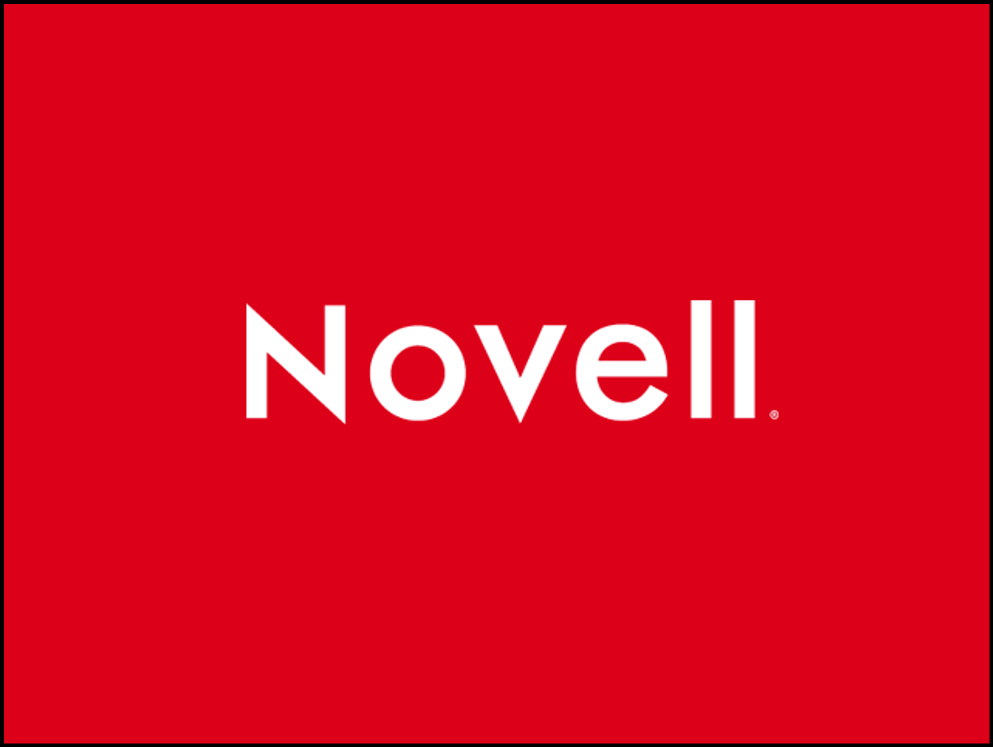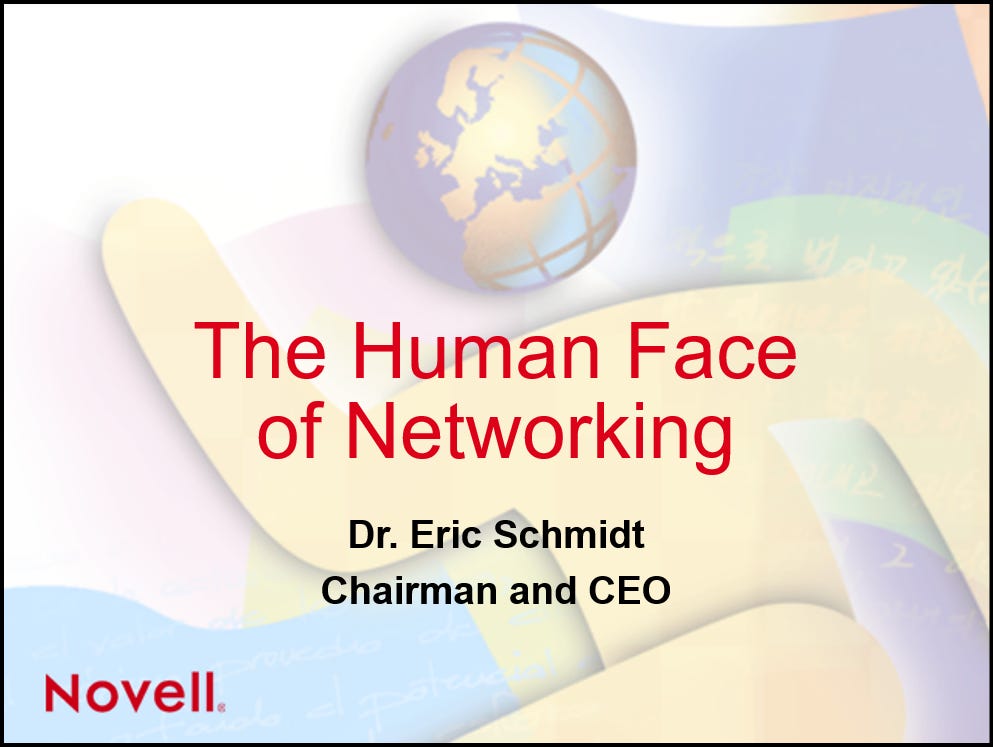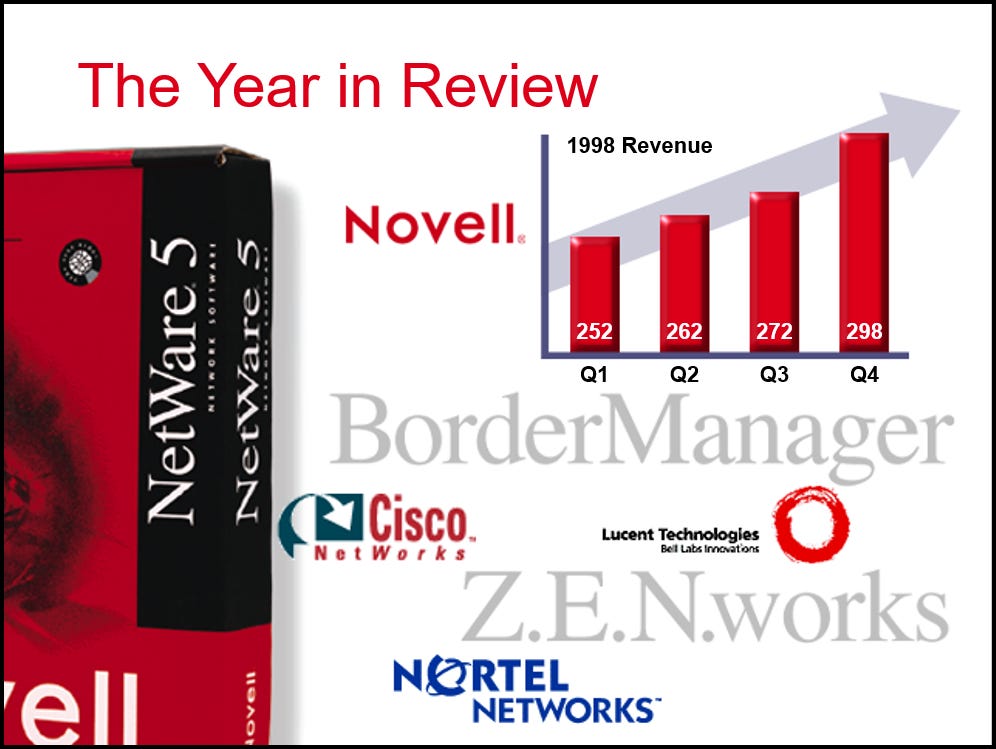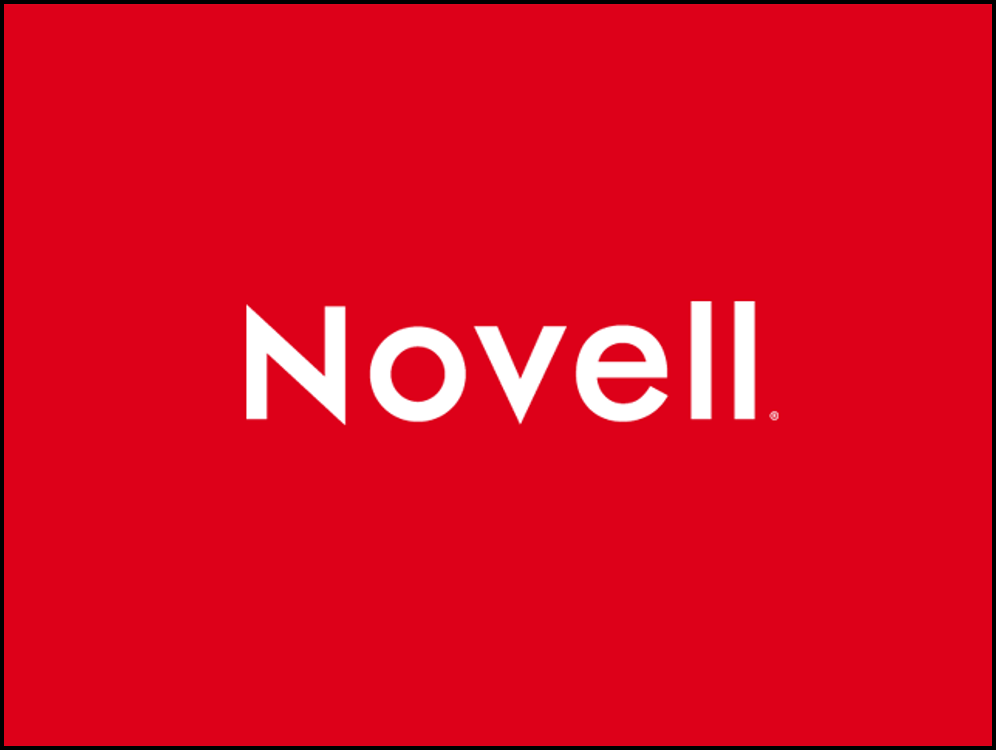Letter #174/175: Gokul Rajaram and Eric Schmidt (2023/1999)
Early Operator at Google, Facebook, Square, and DoorDash and CEO of Google | How to Present | Novell 1998 Year in Review Presentation
Hi there! Welcome to A Letter a Day. If you want to know more about this newsletter, see "The Archive.” At a high level, you can expect to receive a memo/essay or speech/presentation transcript from an investor, founder, or entrepreneur (IFO) each edition. More here. If you find yourself interested in any of these IFOs and wanting to learn more, shoot me a DM or email and I’m happy to point you to more or similar resources.
If you like this piece, please consider tapping the ❤️ above or subscribing below! It helps me understand which types of letters you like best and helps me choose which ones to share in the future. Thank you!
Today’s letters are a note from Gokul Rajaram on How To Present and a presentation from Eric Schmidt. In his memo, Gokul shares a story about working with Eric and the lessons he learned from him about presenting. In Eric’s presentation, we get to see the principles he taught Gokul at work.
Gokul and Eric are two of the most accomplished operators in Silicon Valley history. Gokul helped four generational companies (Google, Facebook, Square, DoorDash) go public and Eric helped two very different (one hardware - Sun Microsystems, one internet - Google) companies scale, one of which reached a $1tn market cap. Over their careers, Gokul worked with Mark Zuckerberg at Facebook, Jack Dorsey at Square, and Tony Xu at DoorDash, while Eric worked with Vinod Khosla and Scott McNealy at Sun Microsystems. Gokul and Eric also worked together, and with Larry Page and Sergey Brin, at Google.
Gokul Rajaram is the VP of Product at Doordash, where he leads Caviar. Gokul started his career at Juno Online Services in 1997, where he was a technical lead for advertising systems. After getting an MBA, he joined Onetta as a product manager before starting a legendary 20 year run where he helped four generational companies through their IPOs.
He started at Google in 2003, where he came to be known as one of the “godfathers of Adsense” for his work in the development, launch, and scaling of AdSense from zero to $1bn+ in revenues and a substantial portion of Google’s business (in 3Q2007, AdSense generated $1.45B of Google’s total $4.23B revenue). Google IPOed in 2004, and in 2007, Gokul left to start a startup.
His startup, Chai Labs, was acquired by Facebook in 2010. Post acquisition, Gokul stayed on at Facebook as Product Director of Ads, where he helped the company transition its advertising business to become mobile first and scaled revenues from $750mn to $6.5bn. Facebook IPOed in 2012, and a year later, Gokul joined Square.
At Square, Gokul lead product engineering for their Register product, a full point-of-sale system for businesses. A year later, Square acquired Caviar, and Gokul was tapped to lead the group. Square IPOed in 2015, and then sold Caviar to DoorDash in 2019.
As Caviar went to DoorDash, so did Gokul. DoorDash IPOed just a year later, in 2020. Today, Gokul is still at DoorDash, where he is a self-proclaimed “Product and Business Helper.”
Notably, Gokul also serves on the boards of The Trade Desk, Coinbase, and Pinterest. He graduated from IIT Kanpur, where he was awarded President of India's Gold Medal for being class valedictorian.
Eric Schmidt is the Cofounder of Schmidt Futures. He started his career with a series of internships at Byzromotti Design, Bell Labs, Zilog, and Palo Alto Research Center (PARC). While a summer intern at Bell Labs in 1975, he co-wrote Lex, a computer program that generates lexical analyzers, which became the standard lexical analyzer generator on many Unix and Unix-like systems, and is still in use today. At PARC, he published his PhD thesis on “Controlling Large Software Development in a Distributed Environment,” a exploration of the problems of managing distributed software development and tools for solving those problems.
A year after earning his PhD in electrical engineering and computer science, Eric joined Sun Microsystems as its first software manager. He quickly rose to become Director of Software Engineering, Vice President and General Manager of the Software Products Division, Vice President of the General Systems Group, and the President of Sun Technology Enterprises.
After a tremendous ~15 year run at Sun (the company generated ~$9bn of revenue the year he left), Eric became the CEO and Board Chair of Novell. During this time, he was recruited to be the CEO of General Magic, but never showed up on his scheduled first day — Novell had managed to convince him to stay. Eric ultimately left in 2001 after the acquisition of Cambridge Technology Partners.
In 2001, Google was a fast growing start-up facing some growing pains. The two lead investors of their Series A, Sequoia Capital and KPCB, were not happy with Larry’s and Sergey’s management style and demanded they be redeemed, at cost, unless Google brought in “adult supervision” in the form of a new CEO. Eric was that CEO.
Eric joined Google in 2001 as Chairman and CEO, where he was tasked with “building the corporate infrastructure needed to maintain Google's rapid growth as a company and on ensuring that quality remains high while the product development cycle times are kept to a minimum.” He did exactly that, pioneering the company’s transformation from a Silicon Valley startup to a global technology leader. He oversaw their 2004 IPO (as CEO from 2001-2011) and their 2015 reorganization to Alphabet (as Chairman of Google from 2001-2015 and Executive Chairman of Alphabet from 2015-2018), and saw the company become just the third US tech company cross $1tn in market cap in 2020 while a Technical Advisor (2018-2020).
Notably, Eric served on the Board of Apple from 2006-2009, but stepped down when competition between iOS and Android got serious (the iPhone was released in 2007).
I hope you enjoy this note and presentation as much as I do!
Related Resources
Sun Microsystems
Meta Podcast (2 hours) [Free]
Meta Deep Dive (Full report: 166 pages)
Meta Business History (~18 pages)
Peter Thiel Compilation (536 pages)
Marc Andreessen Compilation (1386 pages)
Square
DoorDash
Gokul’s Memo
How to present
In 2006, I helped Eric Schmidt create a deck outlining Google’s strategy, for a presentation Eric was delivering to the company. It taught me a profound lesson on how to present.
When I showed up to my first meeting with Eric, he asked me to visit with every product team at Google, chat with them to figure out what they were working on, and then summarize it on one slide (for each team).
Easy enough, I thought. I would use 3-5 bullet points per slide. Piece of cake. I started mentally mapping things out and got ready to leave.
“But”, Eric said, “I want no words on any slide”.
My well-laid plans disintegrated in an instant. How was I supposed to convey the key messages from each team, without WORDS?
Eric must have seen the panic on my face, and kindly gave me a hint. “Put the text in speaker notes”.
“But what goes on the slides, Eric?” I continued panicking.
That classic, gentle “Eric smile” fluttered on his face. “Why, images, of course!”
“You mean, you want each slide to just be comprised of images?”
“You got it. And use the title wisely. 7-8 words max. Let’s meet in a week to review progress.”
As I left the meeting, little was I to know that this conversation would fundamentally change my view on how to deliver effective presentations.
17 years later, I still cling tightly to the following principles:
The larger the audience, the fewer the words on the slide. In Eric’s case, the audience was thousands of employees, so we had 0 words per slide.
The title does most of the heavy lifting, which means it cannot be passive. It must be action oriented. Eg: not “Subscriber retention” but “Subscribers continue to be retained strongly” or even better “Net revenue retention continues to be > 100%”.
Use memorable images that substantiate and give credence to the words of the title. This image is what will occupy most of the slide area, so you need to spend much of your time thinking about what picture will best get the point (made by the title) across. In some cases, it might be a customer image or logo. in other cases, a graph. In yet other cases, it could be something else entirely. For the Google presentation, one of the images that gave me the most trouble was a slide on Google Search Appliance and other Enterprise products. The title stated that these products were increasingly being used by larger customers. The team didn’t want to share customer logos broadly since some were confidential, so logos were not an option. I decided to go with a trend line on the % of searches from enterprise customers, but the person who was supposed to pull this data for me, flaked at the last minute and I had to scramble. I ended up scrambling to create a mosaic of a bunch of consumer product logos with some kind of icon that denoted large enterprises. Not my finest moment but it got the point across.
Use speaker notes. Like Eric said, speaker notes should contain most of the details. It puts a lot of burden on the speaker since they cannot just read off the slides. But this doesn’t deter good speakers, since they prepare dozens of times, and then again.
So there you have it: my 4 principles for delivering compelling presentations to live audiences.
(CAVEAT: If the presentation has to be emailed to an audience who will consume it asynchronously, that’s completely different and has different rules).
How did the 2006 Google strategy presentation turn out, you ask? It went quite well, and later I got a nice thank you note from Eric. I didn’t realize at the time that I should have been the one thanking him for the once-in-a-lifetime learning opportunity.
Eric’s Presentation
Slide 1
Slide 2
Slide 3
Slide 4
Slide 5
Slide 6
Slide 7
Slide 8
Slide 9
Slide 10
Slide 11
If you got this far and you liked this piece, please consider tapping the ❤️ above, subscribing, or sharing this letter! It helps me understand which types of letters you like best and helps me choose which ones to share in the future. Thank you!
Wrap-up
If you’ve got any thoughts, questions, or feedback, please drop me a line - I would love to chat! You can find me on twitter at @kevg1412 or my email at kevin@12mv2.com.
If you're a fan of business or technology in general, please check out some of my other projects!
Speedwell Research — Comprehensive research on great public companies including Constellation Software, Floor & Decor, Meta (Facebook) and interesting new frameworks like the Consumer’s Hierarchy of Preferences.
Cloud Valley — Beautifully written, in-depth biographies that explore the defining moments, investments, and life decisions of investing, business, and tech legends like Dan Loeb, Bob Iger, Steve Jurvetson, and Cyan Banister.
DJY Research — Comprehensive research on publicly-traded Asian companies like Alibaba, Tencent, Nintendo, Sea Limited (FREE SAMPLE), Coupang (FREE SAMPLE), and more.
Compilations — “An international treasure”.
Memos — A selection of some of my favorite investor memos.
Bookshelves — Collection of recommended booklists.














